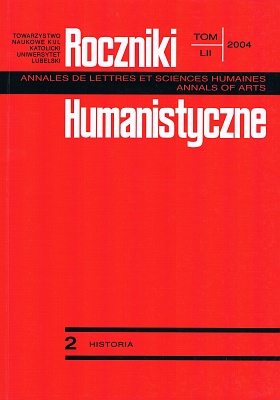Organization of Ukrainian Nationalists during the Second World War
Abstract
The outbreak of World War II found the Organization of Ukrainian Nationalists (OUN) divided into two fractions: the supporters of Stepan Bandera and those of Andrij Melnyk. The conflict was based on differences on the strategy of struggle for independence as well as on the generation conflict. Bandera, representing young national activists, was of the opinion that OUN's actions in the lands occupied by the Soviets should be intensified, and its politics should be independent of any outer factors. Melnyk, in turn, who managed the OUN's Prowid, (Leadership) was supported by Ukrainian emigration circles – by veterans of World War I and of struggle for independence of the years 1917-1921. He represented the conservative wing, opting for a closer collaboration with the Third Reich, in whose politics he saw the factor that could change the Versailles order.
In the years 1940-1941 the final split happened in the OUN. Two organizations emerged, which started fighting each other: OUN-M [supporters of Melnyk] and OUN-B [supporters of Bandera]. Despite the differences concerning the strategy, both the fractions collaborated to a varying degree with the Germans, getting their support for their own initiatives on the self-government, cultural, economic and military planes.
Both Bandera's and Melnyk's groups treated the German aggression on the USSR as a breakthrough in their attempts to regain independence. However, too much activity, as well as too much autonomy in them, especially on the side of Bandera's camp, that exceeded the limits set by the German leaders, led to a change in German policy towards the Ukrainian nationalists and to use of repressions against them. This, in turn, made the two fractions pass to the underground, which starting from 1942 assumed the form of resistance movement.
The greatest achievement of the nationalist resistance movement was forming the Ukrainian Insurgent Army (UPA) that ultimately was controlled by OUN-B. UPA started to fight at the same time the German occupational troops, the Soviet guerillas and the Polish underground forces striving after independence. OUN-B and UPA are also responsible for mass murders they committed on Polish inhabitants of Volhynia and Eastern Galicia.
Starting with 1943 the nationalist movement represented by OUN-B and OUN-M started slowly to depart from extreme nationalism and the fascist principle of leadership, accepting the rules of pluralism and democracy.
References
Armstrong J. A., Ukrainian Nationalism, New York–London 1963.
Bulba-Boroweć T., Armija bez derżaw, Lviv 1993.
Encykłopedija Ukrainoznawstwa, t. IX, Lviv 2000, reprynt wydań 1955-1984.
Heike W. D., Ukrajinśka Dywizja „Hałyczyna”, Toronto−Paryż−München 1970.
Hrycak J., Historia Ukrainy 1772-1999. Narodziny nowoczesnego narodu, Lublin 2000.
Kosyk W., Ukrajina i Nimeczczyna u druhij switowij wijni, Paryż-Nju-York–Lviv 1993.
Łysiak-Rudnyćkyj I., Istoryczni esse, t. II, Kyjiv 1994.
Mańkowski Z., Między Wisłą a Bugiem. Studium o polityce okupanta i postawach społeczeństwa, Lublin 1978.
Mirczuk P., Narys Istoriji OUN, t. I, Mjunchen−Łondon−Nju-Jork 1968.
Mirczuk P., Ukrajinśka Powstanśka Armija 1942-1952, Lviv 1991, reprynt wydania z 1953.
Pasternak J., Narys istoriji Chołmszczyny i Pidlaszczia, Winnipeg 1968.
Polikarpenko H., Orhaniacija Ukrajinśkych Nacjonalistiw pid czas druhoj switowoj wijny, w: Na zow Kyjewa. Ukrajinśkyj Nacjonalizm u druhij switowij wijni.
Potichnyj P., Polityczna dumka ukrajinśkoho pidpilja 1943-1951, „Zeszyty Naukowe Uniwersytetu Jagiellońskiego. Prace historyczne” 1993, z.103.
Prokop M., Heneza, ustrij i platforma UHWR, „Suczasnist'” 1978, nr7-8.
Sodol' P., Ukrajinska Powstancza Armija, 1943-1949. Dowidnyk, Nju-Jork 1994.
Szuliak O., Wo imjia prawdy, Rotterdam 1947.
Torzecki R., Geneza Rozłamu w Organizacji Ukraińskich Nacjonalistów, „Studia zdziejów ZSRR i Europy Środkowej” t. V, 1969.
Torzecki R, Kwestia ukraińska w polityce III Rzeszy 1933-1945, Warszawa 1972.
Torzecki R., Polacy i Ukraińcy. Sprawa ukraińska w czasie II wojny światowej na terenie II Rzeczypospolitej, Warszawa 1993.
Turowski J., Siemaszko W., Zbrodnie nacjonalistów ukraińskich dokonane na ludności polskiej na Wołyniu 1939-1945, Warszawa 1990.
Ukrajina-Polszcza. Ważki pytannia. Materiały II miznarodnoho seminaru istorykiw „Ukrajinsko-polski widnosyny w 1918-1947 rokach”, Warszawa 22-24 trawnia 1997, t. 1-2.
Wysocki R., Organizacja Ukraińskich Nacjonalistów w Polsce w latach 1929-1939. Geneza, struktura, program, ideologia, Lublin 2003.
Zbirnyk statej, spohadiw i dokumentiw, red. K. Mel'nyk, O. Łaszczenko, B. Weryha, Kyjiw 1993, s. 450-481.
Żdanowycz O., Na partyzanśkomu fronti, w: Na zow Kyjewa. Ukrajinśkyj Nacjonalizm u druhij switowij wijni. Zbirnyk statej, spohadiw i dokumentiw, red. K. Mel'nyk, O. Łaszczenko, B. Weryha, Kyjiw 1993, s. 330-345.
Copyright (c) 2004 Roczniki Humanistyczne

This work is licensed under a Creative Commons Attribution-NonCommercial-NoDerivatives 4.0 International License.





